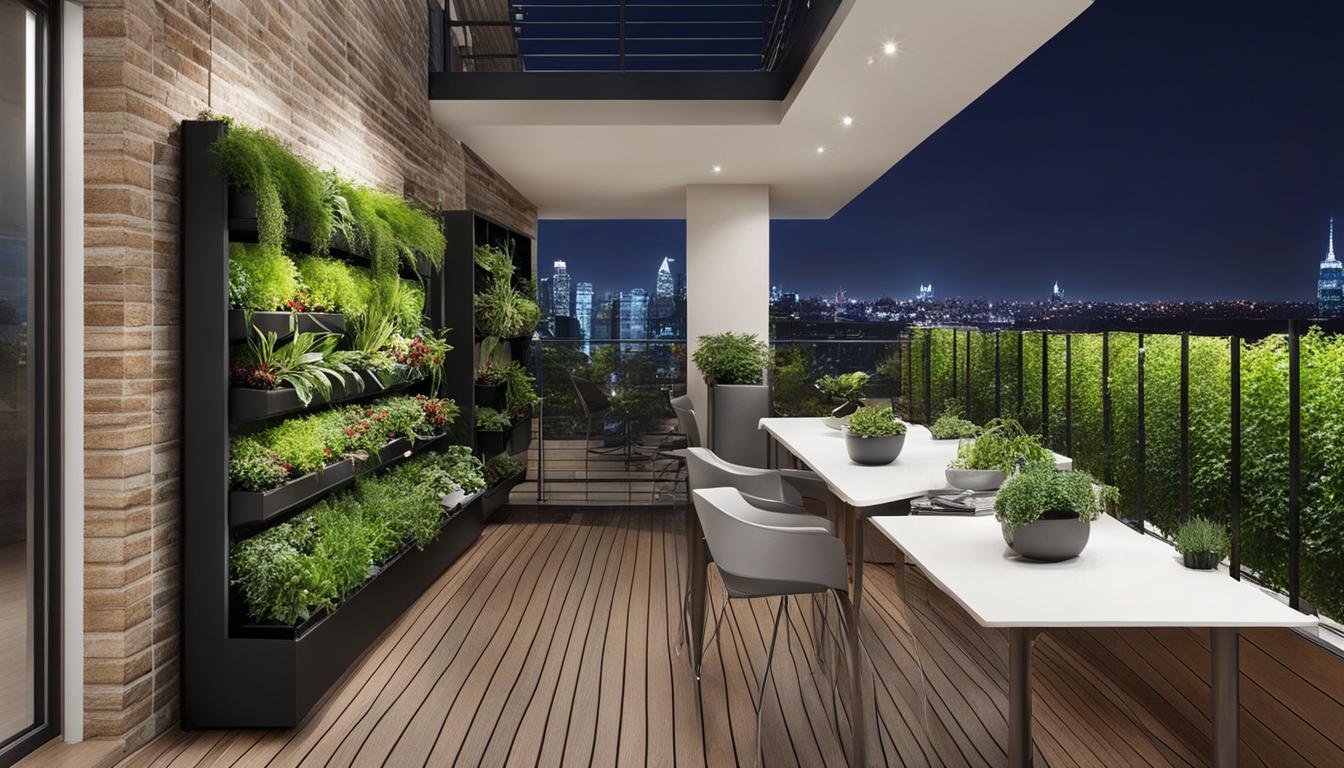
Vertical garden kits are a great solution for small spaces, such as apartments, patios, balconies, and small yards. They allow you to maximize your indoor and outdoor space by utilizing walls and unused areas. Whether you are looking for herb garden ideas or pallet gardens, there are plenty of different types of gardening projects to choose from.
Vertical gardens help optimize limited ground space, improve air quality, enhance aesthetics, increase biodiversity, regulate temperature, reduce noise, and offer easy maintenance and enhanced privacy.
Plant options for vertical gardens include flowers, herbs, strawberries, cherry tomatoes, pole beans, carrots, garlic, onions, salad greens, radishes, peas, squash, succulents, vines, ivy, air plants, and other small plants.
Essential supplies for vertical garden projects include a vertical structure or support, planters, quality soil, plants, gardening tools, watering system, hardware, and optional fertilizer or mulch.
By repurposing materials and incorporating sustainability, you can create a personalized and eco-friendly vertical garden. Embrace the process, let your creativity shine, and have fun with your vertical garden project. Share your experiences and showcase your beautiful and thriving vertical garden spaces.
Key Takeaways:
- Vertical garden kits are ideal for small spaces like apartments, patios, balconies, and small yards.
- They help optimize limited ground space, improve air quality, increase biodiversity, and regulate temperature.
- You can grow a variety of plants in vertical gardens, including flowers, herbs, vegetables, and succulents.
- Essential supplies for vertical gardens include a vertical structure or support, planters, quality soil, plants, and gardening tools.
- By incorporating sustainability and repurposing materials, you can create an eco-friendly vertical garden.
What is vertical gardening and how does it work?
Vertical gardening is a concept that involves growing plants in an upward direction using various support structures instead of spreading them across the ground. It is a creative and practical solution for maximizing the use of vertical space, making it ideal for small spaces with limited ground area.
Vertical gardening can be accomplished through different methods such as trellises, wall gardens, hanging gardens, and tiered planters. The key idea is to grow plants vertically, defying gravity and making the most of available space.
This technique allows for a wide variety of plants to be cultivated in a relatively small area, promoting biodiversity and adding aesthetic appeal to the surroundings.
By utilizing vertical space, vertical gardening offers several advantages. It optimizes limited ground space, improves air quality, regulates temperature, reduces noise, and enhances privacy.
Also, vertical gardening systems are easy to maintain, making them suitable for busy individuals or those with limited gardening experience.
How does vertical gardening work?
The concept of vertical gardening is based on the idea of utilizing vertical space to grow plants. Instead of spreading plants horizontally across the ground, they are grown vertically with the help of support structures.
For example, a trellis can be erected against a wall or fence, and climbing plants can be trained to grow upwards, utilizing the vertical space. Wall gardens involve attaching planters or containers to a vertical surface, allowing plants to grow in a vertical arrangement.
Hanging gardens utilize hanging baskets or containers to suspend plants from a wall, ceiling, or other elevated structures. Tiered planters provide multiple levels or tiers for plants to grow, creating a vertical garden.
Vertical gardening works by providing plants with the necessary support and space to grow vertically. This allows for the cultivation of a greater number of plants in a smaller area, making it an efficient gardening technique for small spaces.
| Advantages of Vertical Gardening |
|---|
| Optimizes limited ground space |
| Improves air quality |
| Regulates temperature |
| Reduces noise |
| Enhances privacy |
| Easy maintenance |
Benefits of Vertical Garden Kits for Small Spaces
Vertical garden kits offer a range of benefits for small spaces, making them an ideal solution for anyone looking to create a lush garden in a limited area. These kits provide an efficient way to maximize the available space by utilizing walls, fences, or balconies. By going vertical, you can optimize your small space and transform it into a thriving oasis.
One of the key advantages of using vertical garden kits in small spaces is space optimization. These kits allow you to grow plants in upward directions, taking advantage of vertical areas that would otherwise remain unused. With a vertical garden kit, you can cultivate a variety of plants without taking up precious ground space.
Another benefit is the aesthetic appeal that vertical gardens bring to small spaces. By adding greenery to your walls or fences, you can create a visually pleasing environment that enhances the overall ambiance of your space.
Vertical gardens also contribute to improved air quality, increased biodiversity, and temperature regulation, creating a healthier and more comfortable living environment.
Advantages of Vertical Garden Kits for Small Spaces:
- Space optimization by utilizing vertical areas
- Enhanced aesthetic appeal
- Improved air quality and increased biodiversity
- Temperature regulation and noise reduction
- Easy maintenance and enhanced privacy
Vertical garden kits offer an array of plant options, allowing you to create a garden that suits your preferences and needs. Whether you want to cultivate colorful flowers, fragrant herbs, or fresh vegetables, there is a vertical garden kit that can accommodate your chosen plants.
With all the necessary supplies and instructions included, vertical garden kits make it easy to set up and maintain your garden. From the vertical structure or support to the quality soil and planters, these kits provide everything you need to get started on your small space gardening project.
Whether you have a balcony, patio, or small yard, a vertical garden kit can help transform your limited space into a flourishing oasis.
| Advantages of Vertical Garden Kits for Small Spaces | |
|---|---|
| Space optimization by utilizing vertical areas | Enhanced aesthetic appeal |
| Improved air quality and increased biodiversity | Temperature regulation and noise reduction |
| Easy maintenance and enhanced privacy |
Vertical garden kits offer a range of benefits for small spaces, making them an ideal solution for anyone looking to create a lush garden in a limited area.
These kits provide an efficient way to maximize the available space by utilizing walls, fences, or balconies. By going vertical, you can optimize your small space and transform it into a thriving oasis.
One of the key advantages of using vertical garden kits in small spaces is space optimization. These kits allow you to grow plants in upward directions, taking advantage of vertical areas that would otherwise remain unused. With a vertical garden kit, you can cultivate a variety of plants without taking up precious ground space.
Another benefit is the aesthetic appeal that vertical gardens bring to small spaces. By adding greenery to your walls or fences, you can create a visually pleasing environment that enhances the overall ambiance of your space.
Vertical gardens also contribute to improved air quality, increased biodiversity, and temperature regulation, creating a healthier and more comfortable living environment.
Vertical garden kits offer an array of plant options, allowing you to create a garden that suits your preferences and needs. Whether you want to cultivate colorful flowers, fragrant herbs, or fresh vegetables, there is a vertical garden kit that can accommodate your chosen plants.
With all the necessary supplies and instructions included, vertical garden kits make it easy to set up and maintain your garden. From the vertical structure or support to the quality soil and planters, these kits provide everything you need to get started on your small space gardening project.
Whether you have a balcony, patio, or small yard, a vertical garden kit can help transform your limited space into a flourishing oasis.
Choosing the Right Vertical Garden Kit for Your Small Space
When it comes to selecting a vertical garden kit for your small space, there are several factors to consider. The right kit will depend on the size and layout of your space, the available sunlight, and the type of surface you’ll be attaching the garden to. It’s important to choose a kit that is suitable for your specific needs and requirements.
There are various types of vertical garden kits available, including stackable planters, wall-mounted pots, hanging planters, and pocket planters. Each type has its own advantages and limitations, so it’s important to choose one that best fits your space and gardening goals.
Consider the size, durability, and material of the kit, as well as its ease of installation and maintenance. Take into account your plant preferences and the type of plants you intend to grow.
Whether you prefer flowers, herbs, or vegetables, there is a vertical garden kit that can accommodate your specific needs. Do your research, read reviews, and compare prices to make an informed decision and find the right vertical garden kit for your small space.
Factors to Consider When Choosing a Vertical Garden Kit
1. Size and layout of your space: Assess the available space and choose a kit that fits your specific needs.
2. Sunlight and surface type: Consider the amount of sunlight your space receives and choose a kit that is suitable for the surface you’ll be attaching the garden to.
3. Type of kit: Decide whether you want stackable planters, wall-mounted pots, hanging planters, or pocket planters based on your preferences and gardening goals.
4. Size, durability, and material: Consider the size and durability of the kit, as well as the material it is made of, to ensure it will withstand the elements and last for a long time.
5. Ease of installation and maintenance: Choose a kit that is easy to install and maintain, making it convenient for you to take care of your vertical garden.
By considering these factors and choosing the right vertical garden kit, you can create a beautiful and thriving garden in your small space.
Comparison of Vertical Garden Kits
| Vertical Garden Kit | Features | Price |
|---|---|---|
| Stackable Planters | Allows for easy customization and expansion | $ |
| Wall-Mounted Pots | Utilizes vertical wall space | $$ |
| Hanging Planters | Great for small spaces with limited wall space | $ |
| Pocket Planters | Provides a compact and versatile solution | $$ |
Step-by-step guide to creating a vertical garden in small spaces
Creating a vertical garden in a small space can seem daunting, but with the right approach, it can be an enjoyable and rewarding project. Follow these steps to create your own thriving vertical garden:
- Assess your space: Take a good look at your small space and identify the available vertical surfaces that can be utilized for your vertical garden. This can include walls, fences, balconies, or even hanging structures.
- Choose the right plants: Consider the amount of sunlight and the climate of your location. Select plants that are suitable for the available light and can thrive in your specific conditions. Opt for plants that have a compact growth habit or can be trained vertically.
- Select the appropriate containers: Depending on the chosen plants, select containers that are suitable for vertical gardening. Wall-mounted planters, hanging baskets, or stackable pots can be great options for small spaces.
- Prepare the soil and plant: Use a high-quality potting mix that provides good drainage for your plants. Fill the containers with the soil and carefully plant your chosen plants, ensuring they have enough space to grow.
- Water and maintain: Regularly water your vertical garden, ensuring the soil remains moist but not waterlogged. Pay attention to the specific watering needs of each plant. Additionally, regularly prune and trim your plants to maintain their shape and encourage healthy growth.
Tips for Maintaining a Vertical Garden in Small Spaces
Proper maintenance is crucial for the health and longevity of your vertical garden in a small space. Here are some essential tips for caring for your vertical garden:
- Regular watering: Pay close attention to the watering needs of your plants in a vertical garden. The water may drain more quickly than in a traditional garden, so ensure that your plants receive adequate moisture.
- Pruning and trimming: Regularly trim and prune your plants to maintain their shape and prevent overcrowding. This will also help promote healthy growth and prevent diseases.
- Fertilizing: Provide your plants with the necessary nutrients by fertilizing them regularly. Choose a suitable fertilizer, either organic or synthetic, and follow the instructions for application.
- Weed control: Keep your vertical garden free from weeds by regularly inspecting and removing any unwanted plants. Weeds can compete with your desired plants and affect their growth.
- Pest management: Monitor your vertical garden for pests and take appropriate measures to prevent infestations. Use organic pest control methods whenever possible to avoid harm to beneficial insects.
- Seasonal care: Adjust your maintenance routine according to the changing seasons. Some plants may require protection from frost or excessive heat, so be prepared to provide the necessary care.
By following these tips, you can ensure that your vertical garden thrives in your small space, bringing beauty and greenery to your surroundings.
Maintenance Schedule
| Task | Frequency |
|---|---|
| Watering | 2-3 times a week, as needed |
| Pruning and trimming | Monthly |
| Fertilizing | Every 4-6 weeks |
| Weed control | Weekly |
| Pest management | As needed |
| Seasonal care | Spring and fall |
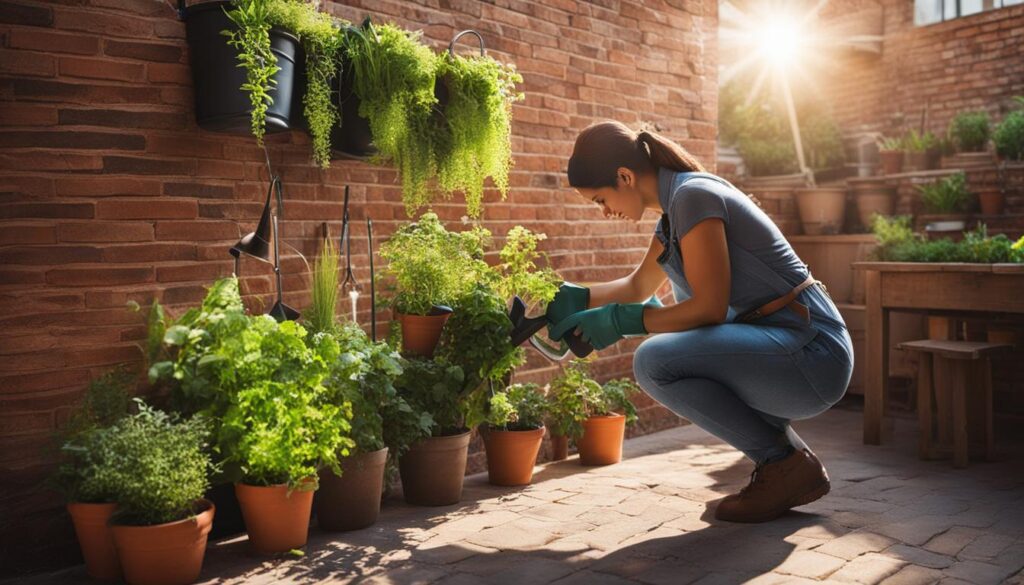
Following a regular maintenance schedule will help keep your vertical garden in optimal condition throughout the year. Remember to adjust the frequency and tasks based on the specific needs of your plants and the environmental conditions in your small space.
Success Stories of Vertical Gardens in Small Spaces
Vertical gardens in small spaces have sparked the creativity and ingenuity of many individuals, resulting in inspiring success stories.
These real-life examples showcase the transformative power of vertical gardens, turning limited areas into breathtaking green spaces. From apartment balconies to windowsills and indoor walls, these success stories demonstrate the endless possibilities and potential of vertical gardening in small spaces.
One notable success story is Sarah’s balcony garden. With limited space, Sarah transformed her small balcony into a lush oasis by utilizing vertical gardening techniques.
She installed a wall-mounted planter and carefully selected a variety of plants, including colorful flowers, herbs, and cascading vines. Despite the limited square footage, Sarah’s balcony garden provides a vibrant and inviting space that brings joy and relaxation.
Another inspiring success story is John’s indoor vertical garden. Living in a small apartment, John wanted to bring the beauty of nature indoors. He created a stunning living wall using a modular vertical garden system.
By carefully selecting a mix of foliage and flowering plants, John transformed his living room into a visually captivating and tranquil space. The vertical garden not only adds aesthetic appeal but also improves air quality and creates a sense of connection with nature.
These success stories highlight the endless possibilities of vertical gardens in small spaces. With a little creativity, planning, and the right supplies, you can create a thriving and visually appealing vertical garden that transforms your small space into a haven of greenery and serenity.
DIY Projects for Vertical Gardens in Small Spaces
Creating a vertical garden in a small space can be a rewarding DIY project that allows you to unleash your creativity and transform your surroundings. With a few simple materials and some ingenuity, you can design and build your own unique vertical garden structure.
Here are some DIY vertical garden ideas to inspire and guide you:
- Vertical Pallet Garden: Repurpose an old wooden pallet by attaching small pots or planters to the slats. Fill them with your favorite plants and herbs for a charming and space-saving garden.
- Gutter Gardens: Attach gutters horizontally to a wall or fence and plant herbs and small flowers in each section. This creates a cascading effect that adds visual interest to your vertical garden.
- Shoe Organizer Planters: Hang a fabric shoe organizer against a wall and fill each pocket with soil and plants. This is a simple and inexpensive way to create a vertical garden with multiple planting spaces.
- Vertical Succulent Wall: Arrange a variety of succulent plants in a vertical planter or frame. Succulents are low-maintenance and thrive in small spaces, making them perfect for vertical gardens.
Remember to choose plants that are suitable for your specific environment, considering factors such as sunlight, water requirements, and temperature. With a little creativity and resourcefulness, you can create a stunning vertical garden that brings beauty and nature into your small space.
Comparison of DIY Vertical Garden Ideas
| DIY Vertical Garden Idea | Description | Difficulty Level | Cost |
|---|---|---|---|
| Vertical Pallet Garden | Repurpose an old wooden pallet and attach small pots or planters to the slats | Easy | Low |
| Gutter Gardens | Attach gutters horizontally to a wall or fence and plant herbs and small flowers | Moderate | Low |
| Shoe Organizer Planters | Hang a fabric shoe organizer and fill each pocket with soil and plants | Easy | Low |
| Vertical Succulent Wall | Arrange a variety of succulent plants in a vertical planter or frame | Moderate | Medium |
Enhancing your Vertical Garden with Accessories
Accessories can play a significant role in enhancing the visual appeal and personality of your vertical garden. By incorporating the right accessories, you can create a unique and inviting space that reflects your style and taste. From simple additions like fairy lights to colorful plant markers and small garden ornaments, the options are endless.
Some popular accessories for small space vertical gardens include:
- Fairy lights: Add a touch of magic and create a whimsical atmosphere in your vertical garden by stringing fairy lights along trellises or planters. They can illuminate your space during the evening and add a cozy ambiance.
- Colorful plant markers: Use colorful plant markers to label your different plant varieties. Not only do they serve a practical purpose, but they also add a pop of color and visual interest to your vertical garden.
- Small garden ornaments: Incorporate small garden ornaments like bird feeders, wind chimes, or decorative statues into your vertical garden. These ornamental elements can add personality and create focal points within your garden space.
When selecting accessories for your vertical garden, consider the overall style and theme you want to achieve. Choose items that harmonize with your plant selection and add visual interest without overpowering the natural beauty of the plants themselves.
| Accessory | Description |
|---|---|
| Fairy lights | String lights that create a magical and enchanting atmosphere |
| Colorful plant markers | Markers to label plant varieties and add a pop of color |
| Small garden ornaments | Add decorative elements like bird feeders or wind chimes to create focal points |
Sustainable Practices for Vertical Gardening in Small Spaces
Incorporating sustainable practices in vertical gardening is not only beneficial for the environment but also for the overall health and success of your plants. By adopting eco-friendly methods, you can create a sustainable vertical garden in your small space. Here are some practices to consider:
1. Use Recycled or Repurposed Materials
Reduce waste by using recycled or repurposed materials for your vertical garden. Instead of purchasing new planters or structures, consider using old containers, pallets, or other items you already have at home. Not only will this save money, but it will also reduce the demand for new materials and minimize the carbon footprint of your garden.
2. Harvest Rainwater
Collecting rainwater is an excellent way to conserve freshwater resources and reduce your reliance on municipal water supplies. Install a rain barrel or a system to capture rainwater from your roof or balcony. Use this harvested water to irrigate your vertical garden, ensuring a sustainable and cost-effective watering solution.
3. Compost Organic Waste
Instead of throwing away organic kitchen waste, compost it to create nutrient-rich soil for your plants. Set up a compost bin or use a composting method suitable for your small space, such as vermicomposting with worms. By composting, you can reduce waste, enrich your soil, and promote the overall health of your vertical garden.
4. Avoid Synthetic Fertilizers and Pesticides
Opt for organic alternatives to synthetic fertilizers and pesticides. Synthetic chemicals can be harmful to the environment, beneficial insects, and even human health. Use organic fertilizers, such as compost or natural amendments, to provide nutrients to your plants. Control pests naturally with methods like handpicking, companion planting, or using organic pest repellents.
5. Implement Energy-Efficient Irrigation Systems
Consider utilizing energy-efficient irrigation systems, such as drip irrigation or smart irrigation technologies. These systems deliver water directly to the roots of your plants, reducing water waste and promoting efficient water usage. Automate your irrigation schedule based on the specific needs of your plants, optimizing water usage while ensuring their well-being.
By incorporating these sustainable practices into your vertical gardening routine, you can create an eco-friendly and environmentally conscious space in your small area. Taking care of the environment while enjoying the beauty and benefits of your vertical garden is a win-win situation for both you and the planet.
Enhancing Your Small Space with Vertical Gardens and Other Elements
Incorporating a vertical garden into your small space can have a transformative effect, adding a touch of nature and beauty to even the most limited areas. But why stop at just the garden? By combining your vertical garden with other elements, you can maximize the visual impact and create a truly enchanting space.
To enhance your small space, consider incorporating art pieces alongside your vertical garden. Whether it’s a vibrant painting, a unique sculpture, or a handmade wall hanging, art can complement the colors and themes of your garden, creating a harmonious and visually captivating environment.
In addition to art, consider adding wall shelves to display small potted plants or decorative items. These shelves can serve as a functional and stylish way to showcase your plant collection or display cherished mementos.
Lastly, create a cozy seating area near your vertical garden to fully enjoy the beauty of nature in your small space. Whether it’s a comfortable chair, a rustic bench, or a cushioned swing, having a designated seating area allows you to relax and immerse yourself in the serene ambiance of your vertical garden.
By incorporating these elements, you can transform your small space into a multifunctional oasis, where the beauty of nature and artistic expression converge to create a truly enchanting environment.
Transforming small spaces with vertical garden kits
Vertical garden kits are the perfect solution for transforming small spaces into thriving green areas. With limited ground space, vertical gardens allow you to utilize walls and unused areas to create a lush and vibrant oasis. Whether you have a tiny balcony, a small patio, or just a narrow strip of space, vertical garden kits offer a versatile and innovative way to maximize your surroundings.
By incorporating vertical gardens into your small space, you can enjoy numerous benefits. Not only do they optimize space and improve air quality, but they also enhance the aesthetic appeal of your environment.
Vertical gardens increase biodiversity, regulate temperature, reduce noise, and require easy maintenance, making them an ideal choice for small spaces.
Transforming your small space with a vertical garden kit is a simple and rewarding process. With the right supplies and careful planning, you can create a personalized oasis that reflects your taste and style.
By embracing the potential of vertical gardening, you can maximize your small space and embark on a green journey that offers beauty, benefits, and a touch of nature in your daily life.
FAQ
Can I use a vertical garden kit for small spaces?
Yes, vertical garden kits are a great solution for small spaces such as apartments, patios, balconies, and small yards. They allow you to maximize your indoor and outdoor space by utilizing walls and unused areas.
What is vertical gardening and how does it work?
Vertical gardening is a technique that involves growing plants upward using various support structures instead of spreading them across the ground. It is a creative and practical way to optimize vertical spaces such as walls, fences, or balconies, making it ideal for small spaces with limited ground space.
What are the benefits of vertical garden kits for small spaces?
Vertical garden kits offer numerous benefits, including space optimization, improved air quality, aesthetic appeal, increased biodiversity, temperature regulation, noise reduction, easy maintenance, and enhanced privacy.
How do I choose the right vertical garden kit for my small space?
When selecting a vertical garden kit for your small space, consider factors such as the size and layout of your space, available sunlight, wind patterns, and the type of surface you will be attaching the garden to. Research different options, read reviews, and compare prices to make an informed decision.
What is the step-by-step process for creating a vertical garden in small spaces?
To create a vertical garden in a small space, you should assess your space, choose the appropriate vertical gardening system, select suitable plant varieties, gather the necessary supplies, prepare your vertical structure or support, plant your chosen plants, provide proper maintenance, and enjoy the beauty of your thriving vertical garden.
What are some tips for maintaining a vertical garden in small spaces?
To maintain a vertical garden in a small space, it is important to provide proper watering, fertilization, pruning, and pest control. Regularly check for any signs of plant stress or disease, and address any issues promptly. Proper maintenance will help ensure the health and longevity of your vertical garden.
Are there any success stories of vertical gardens in small spaces?
Yes, there are many inspiring success stories of vertical gardens in small spaces. Real-life examples showcase the potential for transforming limited areas into breathtaking green spaces. These success stories demonstrate the creativity, resourcefulness, and passion of individuals who have created stunning vertical gardens.
Are there any DIY projects for vertical gardens in small spaces?
Yes, DIY projects offer a cost-effective and personalized approach to creating vertical gardens in small spaces. There are various DIY vertical garden ideas that you can explore to unleash your creativity. Repurposing materials and incorporating your own design and style can create a unique and personalized vertical garden that fits your small space perfectly.
How can I enhance my vertical garden with accessories?
Accessories can add a personal touch and enhance the visual appeal of your vertical garden. Consider incorporating items such as fairy lights, colorful plant markers, and small garden ornaments. Experiment with different types of accessories to find the perfect combination that adds personality and charm to your vertical garden.
What are some sustainable practices for vertical gardening in small spaces?
When vertical gardening in small spaces, consider incorporating sustainable practices such as using recycled or repurposed materials, harvesting rainwater for irrigation, collecting and composting organic waste, avoiding synthetic fertilizers and pesticides, and implementing energy-efficient irrigation systems. These practices minimize the environmental impact of your vertical garden.
How can I enhance my small space with vertical gardens and other elements?
You can enhance your small space by combining your vertical garden with other elements such as art pieces, wall shelves, or comfortable seating arrangements. Select artwork that complements your vertical garden, install wall shelves to display small potted plants or decorative items, and create a cozy seating area to enjoy the beauty of your vertical garden.
How can I transform my small space with vertical garden kits?
Vertical garden kits are a versatile and innovative solution for transforming small spaces into lush and vibrant areas. By utilizing vertical space and choosing the right plants and structures, you can create a thriving and visually appealing vertical garden in your small space.


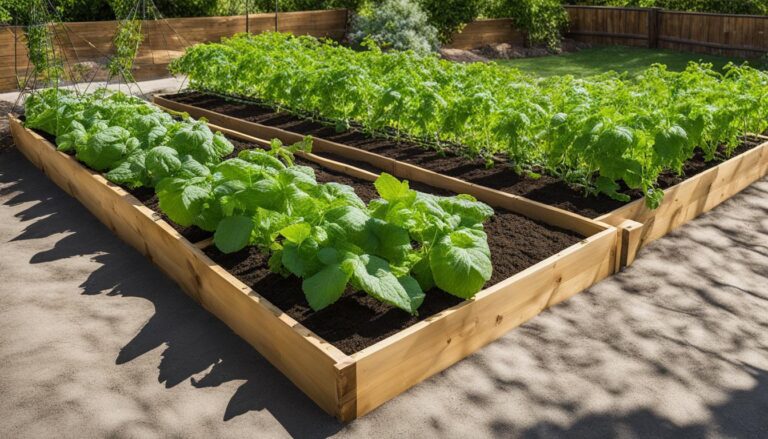


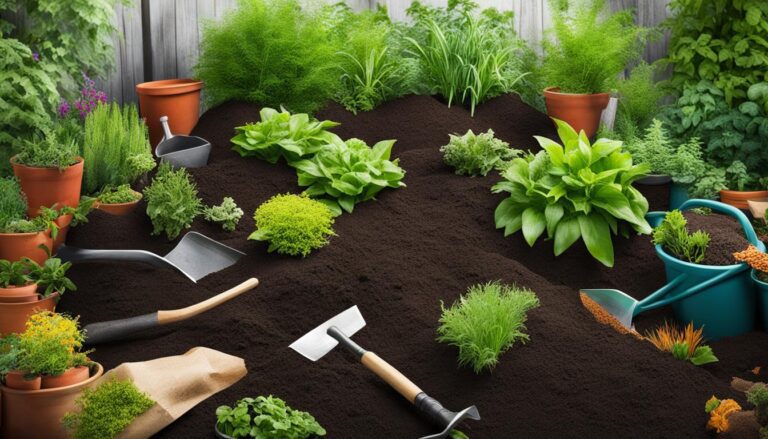
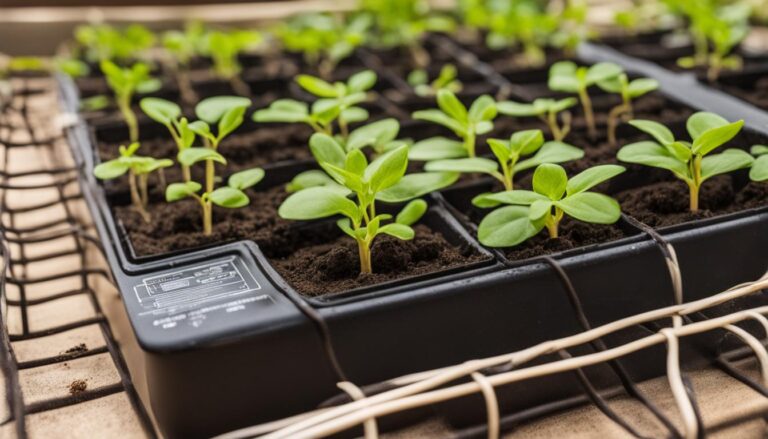
One Comment
Comments are closed.